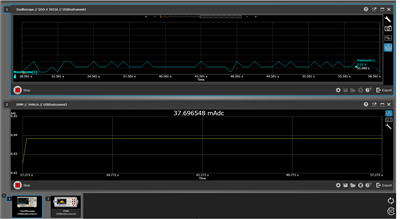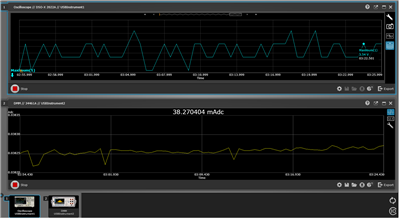I measured power consumption of the CC2538EM while supplying voltage between 2.2V and 3.6V. I am confused with the measurements. I would appreciate if someone helps me to understand it.
The upper row in the below figures shows the maximum DC voltage, the bottom row shows the DC current simultaneous measurement..
Here is a screenshot where the voltage is about 2.2V and 37.69 mA (about 82.918 mW)
Another screen shot that the voltage is about 3.5V and the current is about 38.27 mA (about 133.914 mW)
The above node runs GenericApp of Z-stack Mesh 1.0.0 on CC2538EM (not connected to smartRF06). The external power is supplied on VDD pin of P5 header on the EM board. The above measurements are done on the router node.
I expected to see that the current consumption decreases as the voltage increases, however, the current consumption slightly increases as the voltage increases. Doesn't it suppose to compensate the power consumption by decreasing the drawn current as the voltage increases?
Does it mean that the module will consume less if I keep the voltage less?
Here are some randomly selected sample data:
| Time | Voltage (V) | Current (A) | Power (W) | |||
|
|
|
0.07206330872 | |||
|
|
|
0.08330045815 | |||
|
|
|
0.10959116113 | |||
|
|
|
0.11116634476 | |||
|
|
|
0.11472340968 | |||
|
|
|
0.12098145594 | |||
|
|
|
0.12896320372 | |||
|
|
|
0.1367297944 | |||
|
|
|
0.13868090404 | |||
|
|
|
0.13557748296 | |||
|
|
|
0.13705731786 | |||
|
|
|
0.13224239024 | |||
|
|
|
0.13549311414 | |||
|
|
|
0.13548510312 | |||
|
|
|
0.13546261704 | |||
|
|
|
0.13548807672 | |||
|
|
|
0.13550205264 | |||
|
|
|
0.1339637915 | |||
|
|
|
0.1339556785 |



